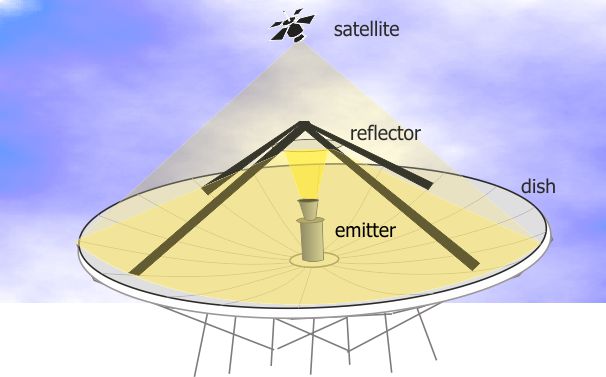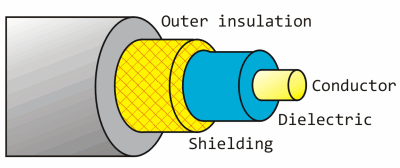Freesat reception - all about dishes
 Brian Butterworth published on UK Free TV
Brian Butterworth published on UK Free TV Satellite reception has both advantages and disadvantages compare with terrestrial (aerial) reception.
By using much higher frequencies (gigahertz, compared to terrestrial televisions megahertz) more transmission channels called transponders (the satellite equivalent of multiplexes) can be provided. For example, there are only six Freeview multiplexes, but Sky or Freesat users can access two hundred satellite transponders.
Aside from exceptional weather conditions (very heavy rain for example) digital satellite provides stable pictures and audio. Where Freeview transmitters are no more than 732 metres above sea level, the geostationary satellites used for television are 35,800,000 metres above the equator so reception is possible even where buildings, trees and hills make terrestrial reception impossible.

The downside of the transmitters being 22,300 miles up in the air is that the signals are very, very weak - so standard TV aerial is of little use. When the signals are sent to the satellites, huge dish transmitters are used to uplink the signal to the satellite. These are tens of metres from side to side, and feature an emitter that generates the signal, which is first bounced of a mirror (called a reflector) and then off the surface of the parabolic dish.

There are many satellites in the sky over the equator. Often these are in clusters over a particular position, for example there are four used for UK television are at 28.2 degrees east. There is another cluster over the 19.2 degrees east positions that are used for German television.
To receive these very weak signals from the satellite, it is necessary to use a dish for reception too. By using a reflective dish, this concentrates the signals onto a small device called a LNB. This is held in front of the dish by a metal arm.

The size of dish for reception is typically much smaller; often 60cm to 100cm in diameter, but the exact size depends upon the transmitting satellite transponder. To keep the transmission power levels down to levels that can be powered by the satellite's solar panels, each beam is focused on a particular area of the Earth's surface. If you are trying to receive the signal at the centre of this zone, a small dish is required. At the outer edges, you may need a 5 metre dish. Maps of these zones are provided by the satellite companies, and are called satellite footprints.
When the dish is installed it must be aligned carefully as the signal is very weak. The installer needs to know the inclination and the azimuth from the ground location to the satellite. If you install yourself you will find that there are markings on the dish that are used to point the dish in the correct position. It is important that the view of the satellite will not be blocked, so must take into account leaves growing on trees and potential building works.
For many people the LNB will have a single cable connected to it, however if you have Sky+ or a multi-room installation the LNB package will actually contain four receivers a quad-LNB. Unlike terrestrial television where you can split the aerial cable to feed more than one Freeview box or television set, with satelite reception you cannot. So, a Sky+ box with two receivers (so you can watch one thing and record another) has two cables connecting the box to the dish.
The cable that connects the dish to the receiver must be satellite grade cable. Whilst this looks superficially like the cable used to connect and aerial to a television, a higher grade cable is required for satellite reception.
Here is an image of a co-axial cable. This sort of cable is used to connect any type of receiving aerial to the reception equipment.

RG6, PF100 and PH100 are all types of coax cable that are suitable for the very weak signals that are received by a satellite dish. (The power is the same as you would receive from a one-bar electric heater on the moon).
The conductor in the centre passes the signals received from the dish to the set-top box. This is made from steel in RG6 cable, and from copper in the RF100 and PH100 types. This makes RG6 less suitable in the UK where rain can damage the cable.
The shielding is responsible for keeping unwanted external interference from damaging the signal. In the cheaper cable this will be a foil wrap, in better specified cables this is a braid (or mesh) of copper wires. The sheild in the RF100 covers 58% of the cable.
The non-conducting layer between the shield and the conductor is called the dielectric. This can be either a solid (RG6), foam (RF100) or air-spaced (PH100) dielectric. This makes the cables progressively more flexible (ie bendy without damage).
10:12 PM
The answer is here:
Changes To BBC HD Channels On Freesat | Join Freesat
The BBC changed the transmission method without telling anyone. A brief alert at the end of a few news bulletins instead of one of the incessant previews might have been helpful.
| link to this comment |
12:40 PM
Hello, I am new to using satelite TV so I was very pleased when I installed my SD Ross system in Bantry southern Ireland, the problem I now have is that the picture keeps jumping and freezing on all channels except Sky News and BBC news 24. My signal strength is 85% and signal quality is 57 to 60%, this is happening intermitently, giving a perfect picture for hours that suddenly breaks up and won't work for hours, I have adjusted the dish three times now and am sure its not that, any ideas? Ross say use the factory re-set or return the receiver and LNB but I don't want to do that if its a simple adjustment thats needed, Martin
| link to this comment |
9:52 PM
Martin:
One suggestion for getting a better quality signal is check the polarity of the LNB. Don't forget the signals from Astra do not come at you true vertical & horizontal.
You may have it slightly alligned wrong.
You may have to upgrade the dish to next size
| link to this comment |
11:44 PM
Using a standard Sky mini-dish with a quad LNB, in the Greater London area with uninterupted site-lines to 28deg East, what signal strength and quality would one typically expect to see on the Sky+ Box signal test page?
Mine is all over the place at times but generally about 60% on strength & 50%-60% on quality - although generally LNB 2 is slightly lower than LNB 1. Over the past couple of evenings there have been momentary signal outages but there have been heavy rain showers
| link to this comment |
4:26 PM
My portable dish set up has suddenly developed a fault. When aligned and receving a strong and good quality signal according to the freesat software programs are not available and show a 'no signal' advice.
| link to this comment |
8:50 PM
my humax freesat box has 2 inlet ports but my ex sky dish has only one outlet port, can i use a coaxial cable splitter instead of laying out the cost for a dual outlet LNB for the dish?.and is there any limit to the distance the splitter is from the freesat box?b ecause i want to eliminate the ammount of coaxial cable in the room.
| link to this comment |
8:57 AM
I have a Humax Freesat box and recently my reception has suffered from a line scrolling up my screen and occasionally the picture pixilates and I get the, "weak or no signal" message.
I have changed my LNB but still have the same problem.
I am running two TV sets from the same Freesat box, so it isn't a problem with the set
| link to this comment |
4:30 PM
Ron Wagg: Check the power supplies for all equipment in the vicinity and ensure that power cables are kept well away from the signal cables.
The scrolling line is likely to be interference from the near-50Hz power on the near-50Hz SCART connection from the box to the TV. If both were exactly the same frequency the line would be static, in the same place all the time.
The intermittent interference is more likely to be mobile phone interference on the satellite cable. Keep your phone well away, or replace the cables with better-screened ones. Satellite connections should always use 'satellite-grade' cable with copper braid over copper foil screening - traditional 'low-loss' coax is not up to scratch and will pick up more noise.
If that doesn't seem to help, check whether the interference is related to some motor or other electrical equipment switching on or off, for example the thermostat or central heating pump. If so, get that equipment checked.
| link to this comment |
7:08 PM
The satelite dish that is on my house was already there when I moved in. There are a row of high trees immediately behind my house that were trimmed and thinned last year. My dish points through a gap in the trees.
I have used freesat trouble free for over a year, but recently, after the trees came into full leaf, I am getting intermitant freeze frame and picture loss, particularly in windy conditions. Is it likely that the trees are the cause, or should I look for something else?
| link to this comment |